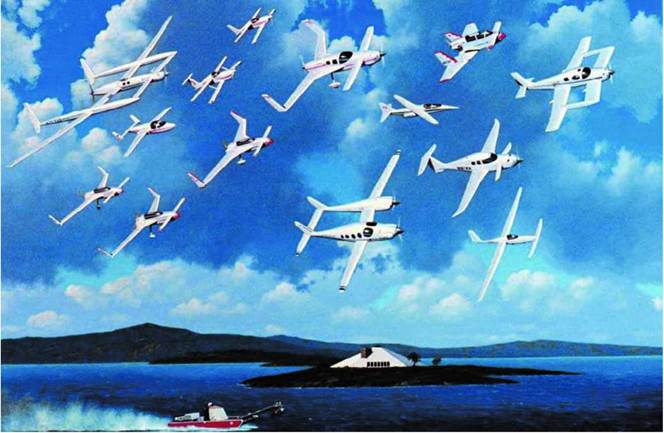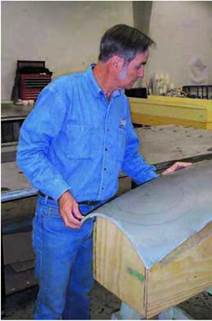Homebuilts and the Step toward Space
After working two years as the director of Bede Test Center for Bede Aircraft, makers of the BD-5J Microjet, Rutan was ready to go it out on his own. In 1974 he founded Rutan Aircraft Factory (RAF) to continue the development of his first airplane, which he began designing back in college and started flying in 1972, and the development of brand new designs.
“I name very few of my airplanes,” Rutan said. “Even the VariViggen, my first one, was named by a guy at work. I told him I was going to build something that was a lot like the Swedish Viggen, except that it had the feature of variable camber that changed the loading. He said, ‘Okay, how about VariViggen.’” Rutan simply replied, “Okay.”
Although Burt Rutan is well known for the use of composites, the VariViggen’s only use of composites was a fiberglass cowling. The aircraft was made out of wood, and its wings were aluminum. However, it had what would become a hallmark of Rutan’s—a canard. The canard was a small wing forward of the main wing that enhanced lift, allowed for slower maneuvering speeds, and helped prevent stalling. The VariViggen was powered by a pusher propeller at the back of the aircraft and had vertical fins at the wingtips called winglets, which improved the rate of climb and cruising speed. These two features also reoccurred in many of Rutan’s designs. Figure 1.2 shows some of Rutan’s earliest aircraft.
Rutan had begun construction of the VariViggen in his spare time while still working for the air force, and it took him four and a half years to complete it. With only seventy-five hours on the aircraft, Rutan flew the VariViggen to Oshkosh, Wisconsin, to give the public its first viewing during the 1972 Air Venture, the annual fly-in held by the Experimental Aircraft Association (EAA), which is the premiere aircraft organization for homebuilts and experimental aircraft. The crowd thrilled at the futuristic-looking aircraft.
“When you look at the wide variety of his designs from the VariViggen to SpaceShipOne and everything in between,” said Tom Poberezny, the President of EAA, “Burt has been a design leader. He’s always been creative and pushing the envelope.
“If you attend a forum at Oshkosh, it is always a packed house because people want to find out what’s the latest and greatest in Burt’s fertile mind. And that becomes motivational for people in terms of the excitement of being inside of design theory, design thinking, and innovation.”
Rutan gave the VariViggen the tail number N27VV. Characteristic of Rutan, the tail numbers of his aircraft weren’t arbitrary. All U. S. aircraft begin with N, but the “27” stood for the model number Rutan gave it, and VV obviously stood for VariViggen.
Another revolutionary aircraft made its debut at the 1972 AirVenture. The tiny little Rand Robinson KR-1—at a length of 12 feet 6 inches (3.8 meters), a wingspan of 17 feet 2 inches (5.2 meters), and a weight of 310 pounds (140 kilograms)—generated a lot of strange looks and disbelief. Ken Rand’s homebuilt aircraft had started people talking and thinking a little differently about the way airplanes were built. The outer wing panels, vertical and horizontal tail surfaces, and other parts of the aircraft were made using polystyrene—the same stuff foam coolers and coffee cups are made.
Even though plywood, which is technically a composite because it is made of wood layers glued together, was also used to build the fuselage, the KR-1 made use of composites like no other aircraft of its time. Polystyrene is very light, but it is also very weak. So, epoxy and cloth made of Dynel, a synthetic fiber, covered the polystyrene in order to give it the rigidity and strength needed to hold together. The KR-1 had a profound influence on the evolution of large-scale use of composite materials in homebuilt aircraft.
Rutan’s next design, the VariEze, also a pusher prop with a canard and winglets, took him only three and a half months to complete by taking the use of composites to a whole new level. “I didn’t have as a goal to build better, lighter, safer, more affordable composite structures. I saw it as a way that I could take a complex aerodynamic shape and build it quickly and get it into flight test,” Rutan said.

ґ
Fig. 1.2. The early aircraft designs and projects of the Rutan Aircraft Factory (RAF) came in many shapes and sizes, including Voyager, AMSOIL Racer, Quickie, Defiant, VariViggen, Grizzly, NGT, Long-EZ, AD-1, Catbird, VariEze, Boomerang, and Solitaire. Provided courtesy of Scaled Composites
V_________________________________________________________________________________________
“The KR-1 was a wooden airplane with Dynel and foam to shape its outer shape. Its primary structure was wood—the fuselage and wings and tail—whereas if you took the wood out of it, it would fall apart. The VariEze was different. Its composite was its primary structure.” The composite Rutan had used was polystyrene foam sandwiched between layers of fiberglass. “I started my composite work with moldless methods that I used on the VariEze and the Defiant and a bunch of our airplanes,” Rutan said. “I did that by copying what they did when they did repairs to molded European sailplanes. European sailplanes were made, and still are, in molds.”
But to fix damage to one of these sailplanes, it wasn’t necessary to go back to the mold. “The brainstorm that I had was, ‘Wait a minute, I could build a whole airplane with these repair methods.’ And that’s how I came up with hotwire wing cores and the hand-carved foam for the fuselage box. And sure enough, I built a whole airplane without a mold.” Figure 1.3 shows Rutan with a composite panel during the assembly process.
Rutan originally had no intention to sell the VariEze. He built it as a research aircraft to do more testing with the canard concept. But during its introduction to the public at EAA’s 1975 Air Venture, the public went wild for the design. Rutan responded by slightly enlarging the design and selling the VariEze as a kit airplane, so homebuilders could purchase plans and components to build it themselves.
“The VariViggen, the VariEze, all these designs, were unique in the fact that they were out of character from the type of design that was typical of the day,”Tom Poberezny said. “He breaks the mold every time he does something.” Figuratively speaking, of course.
In 1986, Rutan’s Voyager made the first nonstop flight around the world without refueling. It lifted off from Edwards Air Force Base with its tanks full of 7,011 pounds (3,181 kilograms) of fuel, circumnavigated the globe without once landing, covering a distance of 24,986 miles (42,212 kilometers), and then touched down nine days later at Edwards Air Force Base with 106 pounds (48 kilograms) of fuel to spare.
The amazing strength-to-weight ratio of the graphite fiber and honeycomb composite that Rutan used to build Voyager allowed a wingspan of 110 feet 8 inches (33.8 meters) and a primary structure weighing in at only 939 pounds (426 kilograms). Fuel actually accounted for 72 percent of its gross takeoff weight.
It was hard not to notice Rutan’s design and engineering prowess. And soon NASA, defense contractors, and large aircraft manufacturers began knocking at the door. In 1982, the year construction actually began on Voyager, Rutan founded Scaled Composites to specialize in prototype development, offering design all the way through flight testing of full-scale vehicles or scaled-down versions and models. Figure 1.4 shows early designs that Scaled Composites worked on, including the
 Starship, Pegasus, and the Pond Racer. Scaled Composites built some of these designs from start to finish, but for others the company only contributed to part of the construction.
Starship, Pegasus, and the Pond Racer. Scaled Composites built some of these designs from start to finish, but for others the company only contributed to part of the construction.
“Things got more conventional,” explained Rutan. “I mean the way we build airplanes. They are still sandwich. They tend to be more honeycomb core than foam core. They tend to prepreg, and we cure them at higher temperatures. We still do them without the autoclave. And we occasionally come up with a breakthrough in manufacturing methods.”
But the manufacturing processes, while important, were never the driving force. As always, it was the design and the need to fly that drove the manufacturing processes. And after about thirty years from the time Rutan graduated college, he started to wonder what was next. Space was never that far from Rutan’s mind, or reach. In his bookshelf was a fat binder that contained original writings of Wernher von Braun. It was the Mars project. Rutan decided, “‘Damn it! Nobody else is going to do this. I’ll do something for space.’ That didn’t dawn on me until about ’93 that if I focused on suborbital, then I could do something interesting.”










